La Casa de los Ecotones is a stately manor, deeply embedded in old-growth chamise, and situated on the border of a dense live-oak woodland. I.e., prime real estate for a pair of Neotoma up-and-comers, like Mrs. Ecotone and her mate.
Not only does the location allow the duskies to forage both ecosystems, but building in the middle of a big chamise shrub, with its sturdy trunk and thick tangle of stout, outwardly arching branches, also protects the house from being dug out by coyotes, foxes and badgers.
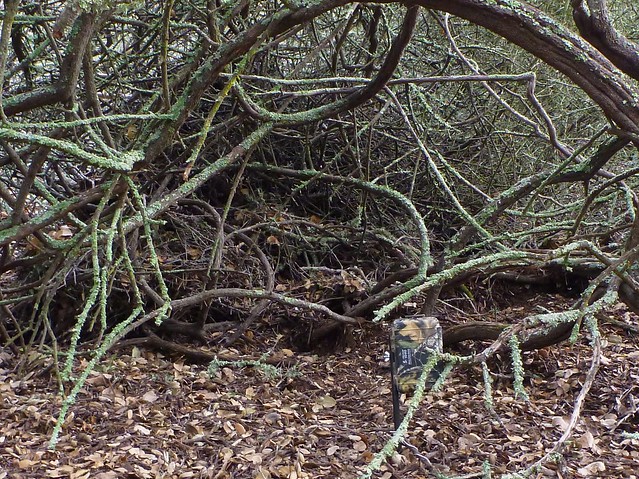
Dusky-footed woodrat house in chamise, on ecotone between chaparral & oak woodland
And, the well-selected spot also creates - around, through and over the house - a very useful tool that fuscipes are happy to refine and exploit: the woodrat branch super highway system.
Being a busy lady, Mrs. Ecotone often uses the highways for her errands:
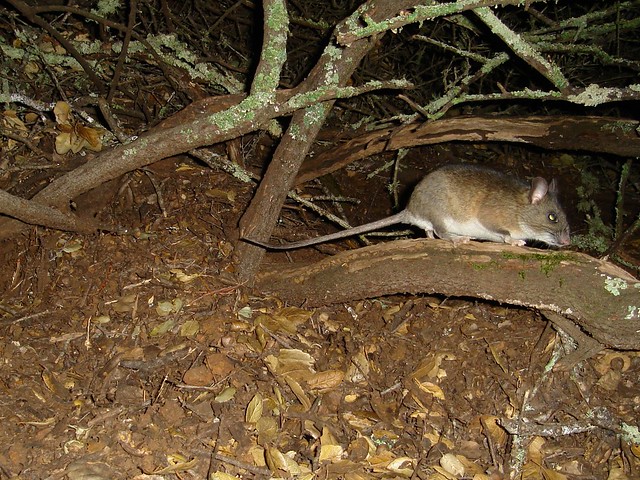
Mrs. Ecotone on the woodrat super highway - note how she uses her tail for balance
Not only do the branch highways allow fast travel, they make it easier for the woodies to orient and navigate. They're also very quiet - unlike walking on dry oak leaves, which can be pretty risky in areas where silent-death-from-above owls are always listening.

Mrs. Ecotone carefully tip-toeing through the noisy oak leaves

Ah - a perch - much better
Her mate, Mr. Ecotone, also uses the branch highways as he comes and goes...
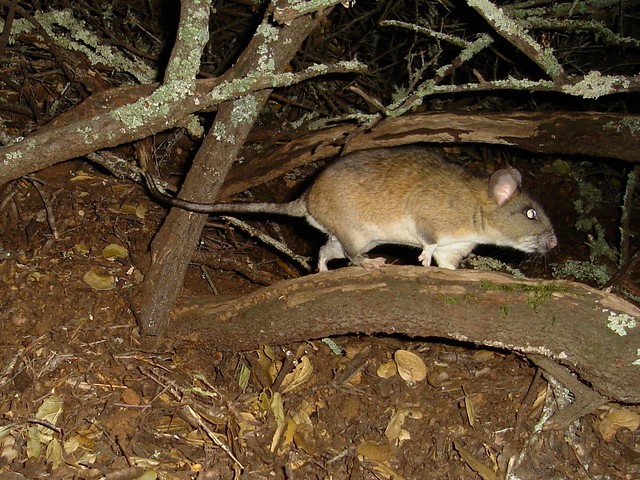
Mr. Ecotone on the super highway
A modern and well-positioned couple, the Ecotones.
I say "couple" in humor, of course. Woodrats aren't specifically monogamous. But, some females have been known to choose the same male each go round, and not mate with any others. I guess those guys must be woodrat Mr. Rights.
In the case of Mrs. Ecotone, she doesn't seem to have any males other than Mr. Ecotone visiting her house. And he appears to be there often - hanging out in front, coming and going, sitting on the door step... (did someone say clingy?)
But, I'm happy for it. Because, his wonderful warm-bloodedness triggered the cam trap and allowed us to catch this treat - a Yellow-eyed Ensatina salamander, Ensatina eschscholtzii xanthoptica, trotting into the stick house entry, right by Mr. Ecotone's feet:

"Come right in Mr. Ensatina. Sorry about the flash. Damn paparazzi." Ensatinas are one of many species of herps that are well known to live in woodrat houses
And, Mr. Ensatina wasn't the only Neotomaphilic tenant seen. Pinyon mice, Peromyscus truei, also live in Mrs. Ecotone's stick house on the edge. And they use the super highways, too:
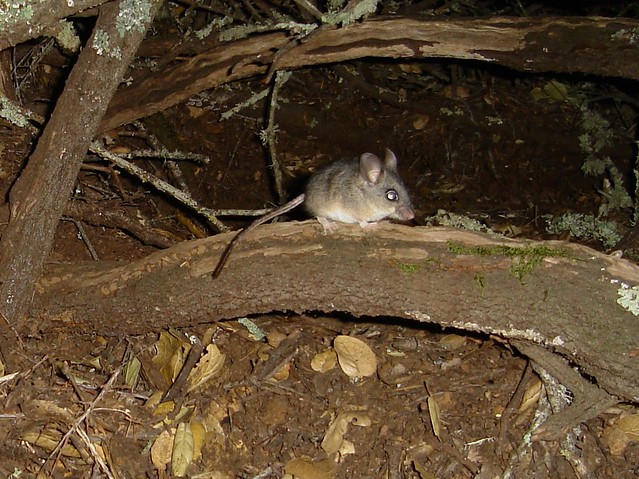
Pinyon mouse, Peromyscus truei, also living in the woodrat's house. The mice and other tenants don't inhabit the same rooms as the woodie, but instead live in the walls, attic and basement - much like when critters move into our homes
The Ecotone's neighborhood is also popular with a few local foragers. Likely they're poking around for inverts or lost seeds...
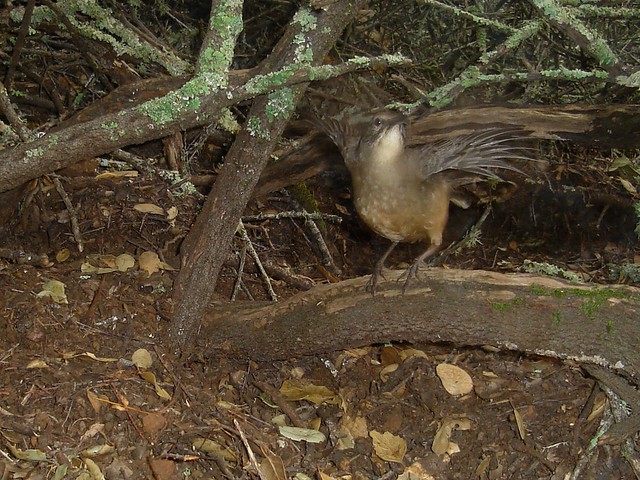
California Thrasher

Juvenile Golden-crowned Sparrow
Ah, yes. Location, location, location. Even in woodrat houses.
Editor's Post-Note: here are 6 woodrat stories that included this post, in order:
- The Coast Packrats
- Battles Under the Bay Laurel
- The Ecotones
- Life on Berry Lane
- Living in the Sticks
- Hanging with Miss Moss
References:
- Numerous amazing papers by Marjorie D. Matocq, Museum of Vertebrate Zoology and Dept. of Interpretive Biology, UC Berkeley, and Dept. Biological Sciences, Idaho State University (and now University Nevada, Reno) - including the following:
- Reproductive success and effective population size in woodrats, Molecular Ecology
- Morphological and molecular analysis of a contact zone in the Neotoma fuscipes species complex, Journal of Mammalogy
- w/ Eileen A. Lacy - Philopatry, kin clusters, and genetic relatedness in a population of woodrats, Behavioral Ecology
- Roberta Fargo, William F. Laudenslayer, Jr., USDA Forest Service - Are house counts reliable estimators of dusky-footed woodrat population size?, Transactions of the Wildlife Society
- Howard F. Sakai, Barry R. Noon, US Forest Service - Between habitat movement of dusky-footed woodrats and vulnerability to predation, Journal of Wildlife Management
- The American Society of Mammalogists, Nov 1991, No. 386 - Neotoma fuscipes
- Dr. C. Hart Merriam - Abstract of a study of the American wood rats, with descriptions of fourteen new species and subspecies of the genus Neotoma, Proceedings of the Biological Society of Washington
- E. W. Jameson, Jr., and Hans J. Peeters, UCPress - Mammals of California
- Smithsonian National Museum of Natural History - Neotoma fuscipes
- Wikipedia - Neotoma fuscipes
- Nature of a Man (this blog) - Battles Under the Bay Laurel
- Nature of a Man (this blog) - The Coast Packrats

Once as I was taking a shortcut through a riparian thicket, I saw a large rodent with a flash of white speed down a horizontal branch. Now I know I was witnessing Neotoma transport routes. How do you tell the difference between male and female woodrats on camera shots? We are all biologists here, it's okay to talk about this stuff.
ReplyDeleteAnother great post RT. I loved that Ensatina picture and it is somewhat interesting that not only do they inhabit middens, but they appear to run into the masters of the house and it bothers neither one of them.
ReplyDeleteI was wondering the same thing as Cindy on sex of the rats since it is hard to get pictures of their bellies. It does seem that the males have more wiry hair especially towards the posterior end of their dorsal side. Are you able to see a bit of the scrotum in some pics and then able to ID individuals and know that pics that do not show sexual dimorphisms are a certain individual that has already been sexed?
You want the woodrat whisperer to spill his secrets, huh? :)
ReplyDeleteMy trick to telling everything from sex to individuals to species of associated mice is pretty straight forward - I leverage quality and quantity. For this set I have 177 high resolution photos of the woodies and their tenants. Coming, going, in numerous angles and locations in the scene, etc. This allows the cross-comparison of size, shape, patterns, ear notches, tail kinks... And, yes, it usually allows me to see the male's scrotum. Especially this time of year, when they're breeding. The male's testicles swell and are more externalized. But after looking at a lot of photos, you also start getting their gestalt, and to me the males look a bit bulkier, and the females sleeker.
Looking at that many pics/house also generally gives you a sense of who the house owner is, and who the visitors are, too.
Great post! The Ensatina catch is definitely something special.
ReplyDeleteWow, you've really outdone yourself. This is an incredible series of posts, both for research/information content and entertainment. I, too, love your Ensatina capture.
ReplyDeleteThanks Katie. I gave a talk on them recently and this is the cam trapping results and info from it, carved into multiple posts. Plus, there's so much poor information on woodrats on the web, that I thought their story needed to be properly told. Up next we learn from Lady Prunus... :)
ReplyDeleteAwesome to get the picture of the Ensatina in there! I always thought those museum dioramas just threw the Ensatina in for the heck of it!
ReplyDelete